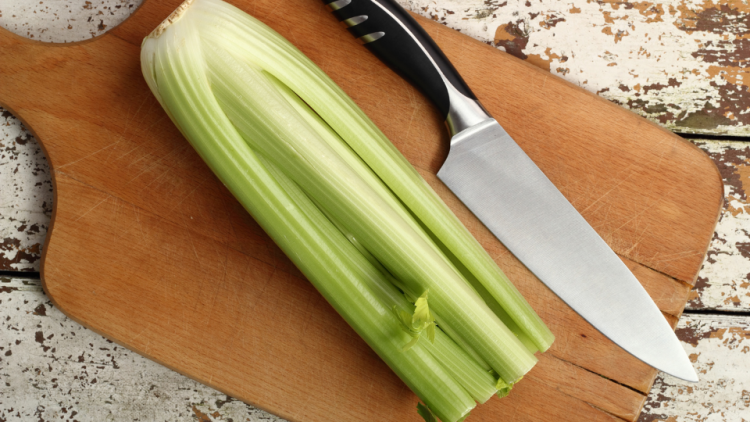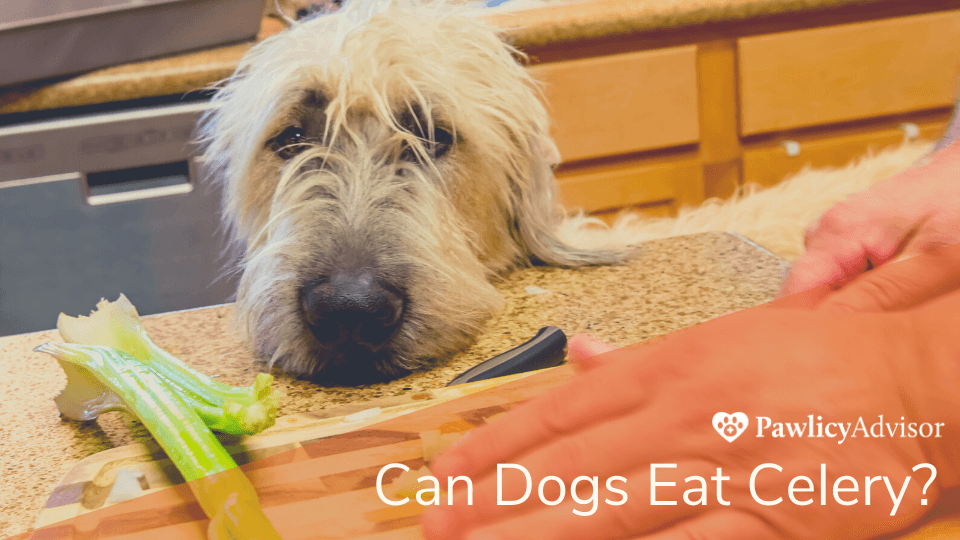Yes, dogs can eat celery as long as it's fed in moderation. If your canine companion eats too much celery, it can cause an upset stomach among other problems. There are a few more caveats to take into consideration before serving your dog this crunchy, low-cal snack that we'll go over in the course of this article.
Here's everything you need to know about safely giving celerey to dogs.
Table of Contents:
- Is celery good for dogs?
- Potential risks of dogs eating celery
- Can dogs eat celery leaves?
- Can dogs eat celery sticks?
- How to serve celery to your dog
- What vegetables are safe for dogs to eat?
- Key Takeaways
Pro Tip: Keeping regular vet appointments is very important when it comes to your pet’s gastrointestinal (GI) health. Once your veterinarian gets to know your pup, they’ll be able to determine whether the animal is experiencing GI upset due to something they ate or whether the issue is more serious. By enrolling your dog in pet insurance, you can offset the financial burden of pet parenting at the vet with up to 90% reimbursement for out-of-pocket costs.
Is celery good for dogs?
Celery offers many health benefits for dogs, including:
Dietary fiber. Celery stalks are rich in fiber, which promotes good digestion and creates a feeling of fullness that can be very beneficial if you’re trying to help your pet lose weight. It's best to serve it in moderate quantities, as too much fiber can result in diarrhea and other GI issues.
Vitamins. This crunchy vegetable is an excellent source of vitamins such as:
- Vitamin A - Great for eyesight, skin, muscles, and nervous system
- Vitamin C - Strengthens the immune system
- Vitamin K - Important for blood cells and bone health
Minerals. Celery contains healthy minerals including:
- Potassium - Functions as an electrolyte, prevents muscle cramps, and regulates blood pressure
- Manganese - Reduces inflammation, strengthens bones, and regulates blood sugar levels
- Zinc - Aids digestion, improves cognitive function, and strengthens the immune system
- Calcium - Facilitates bone growth, as well as proper heart and muscle function
Antioxidants. Antioxidants play a key role in reducing inflammation and defending against disease, so it can help prevent arthritis and cancer in dogs. Antioxidants can also help protect against stomach inflammation that can lead to gastric ulcers1.
Low-calorie treat. One cup of chopped celery has only 19 calories and 1.5 grams of sugar. It’s also low in fat and cholesterol, so it’s a very healthy snack for dogs, especially those who are overweight.
Promotes hydration. Celery is made up of 95% water and packed with electrolytes that help keep dogs hydrated. Feeding your pet celery on a regular basis, especially during the summer, can prevent dehydration.
Fresh breath. Celery is also known to help freshen dogs’ breath, but it can’t replace their standard use of a toothbrush and toothpaste that help minimize dog dental costs.
Potential health issues of dogs eating celery
Although celery is generally considered to be safe for canine consumption, there are a few potential risks that dog owners should be aware of:
- Celery is a diuretic, so if your dog eats large amounts of it, it can cause them to urinate more than usual. In addition, too much calcium and vitamin can lead to urinary stones.
- Due to the high fiber content, eating too much celery can cause GI upset, including bloating, gas, diarrhea, nausea, and vomiting.
- Celery contains high levels of sodium, an important electrolyte that helps regulate the fluid balance in the body. However, too much sodium can lead to increased blood pressure.
- Large amounts of celery can interfere with iodine metabolism, increasing your dog's risk for hypothyroidism.
- Raw celery might present a choking hazard to small breed dogs and puppies, which is why it is important to cut it into small, bite-sized pieces before feeding it to your pet.
As with all new foods, you should slowly introduce celery to your pet's diet. This will allow you to see how the food affects them so you can avoid any potential negative reactions.
Can dogs eat celery leaves?
Owners should be especially careful when feeding dogs celery leaves because they might contain more toxins than other parts of the plant. When grown inorganically, celery is highly susceptible to accumulating pesticides and chemicals used for fertilization. According to What’s on My Food2, a website run by Pesticide Action Network (PAN), the USDA Pesticide Data Program detected 64 possible pesticides in celery.
If the vegetable is washed thoroughly before feeding, there shouldn’t be anything to worry about, but it’s always best to feed organic veggies whenever possible.

Can dogs eat celery sticks?
Yes, dogs can eat celery sticks raw or cooked. Whichever version of the vegetable you choose will depend on what benefits you hope to get out of feeding it to your pet. For instance, if you’re looking to use celery as a crunchy snack that may help freshen your pet’s breath, then serve it whole and raw.
If, on the other hand, you want your pet to benefit from the nutrients present in this healthy veggie, you should cook it first. Canines can’t digest raw veggies as well as humans can, so your dog won't be able to absorb many nutrients when eating raw celery. To maximize the vegetable's health benefits, it's best to serve dogs cooked celery. Otherwise, you can can crush raw celery in a blender, or juice it and pour it over your pup’s food, so they can digest the plant and absorb its nutrients more easily.
How to give celery to dogs
Like any special treat, pet parents should give dogs celery in moderate amounts. Because of the high fiber content, it’s best to slowly introduce this healthy vegetable to your pup’s diet to make sure that they can process it well.
When offering celery for the first time, be sure to observe your pet during and after consumption. You can offer larger dogs a whole stalk of celery, whereas smaller dogs should receive half a stalk or less. To stay on the safe side, cut up the celery stalk into bite-sized pieces before serving it to your dog. Large celery pieces can be a choking hazard, especially for enthusiastic eaters. Additionally, the long, fibrous strands can wrap around the tongue, get caught in the teeth, or cause intestinal issues. If your canine friend seems to get an upset stomach after eating celery, stop offering the veggie and contact your vet.
Pro Tip: A pet insurance plan frees you from financial stress when choosing the best available veterinary care for your canine companion. Picking the right type of pet insurance can cover up to 80% of your vet bills.
Always wash celery thoroughly before serving to reduce pesticide contamination and avoid feeding your dog the leaves, which contain the highest levels of chemicals.
Treats should make up no more than 10% of your dog’s daily diet, especially if they're overweight. As always, when introducing a new food, it’s always a good idea to consult your veterinarian to see if it is a safe option for your specific pet.
Serving ideas
Here are some additional serving suggestions to help you incorporate celery into your pup’s diet:
- Sprinkle a few small pieces of celery on top of your dog’s daily meals.
- Freeze small celery pieces to serve as a hydrating snack on hot summer days.
- If you want to try giving your canine companion celery but worry that they might not like it, try smearing some peanut butter on the stock. Be sure to use dog-safe peanut butter that doesn’t contain xylitol, an artificial sweetener that can be toxic to dogs. Try to limit the amount of peanut butter, as it is very high in calories and fat.
- Combine plain yogurt and small celery pieces and freeze in a Kong ball for a low-calorie treat that will keep your doggy entertained.
What other vegetables are safe for dogs to eat
Most dogs can eat celery without any problems, but some of them will show indifference. If your pup belongs to the latter group, you might be wondering if there are alternative options you can offer.
Other healthy vegetables safe for dogs to ear include brocolli, carrots, and tomatoes.
There are also many fruits that are safe for dogs to eat, such as watermelon, oranges, apples, mango, and small amounts of avocado.
Key Takeaways
- Dogs can safely eat small pieces of celery from time to time. It can be a healthy, low-calorie treat that helps keep your pet’s weight in check, as well as an easy way to freshen their breath.
- Like with most other human foods, it’s best to serve celery in moderate amounts. Too much celery can be difficult for dogs to digest and causes GI issues.
- Be sure to talk to your veterinarian before you start feeding your dog any new foods.
References
- PetMD "Gastroduodenal Ulcer Disease" Accessed Mar. 15, 2021.
- What's on My Plate "Celery" Accessed Mar. 15, 2021.
